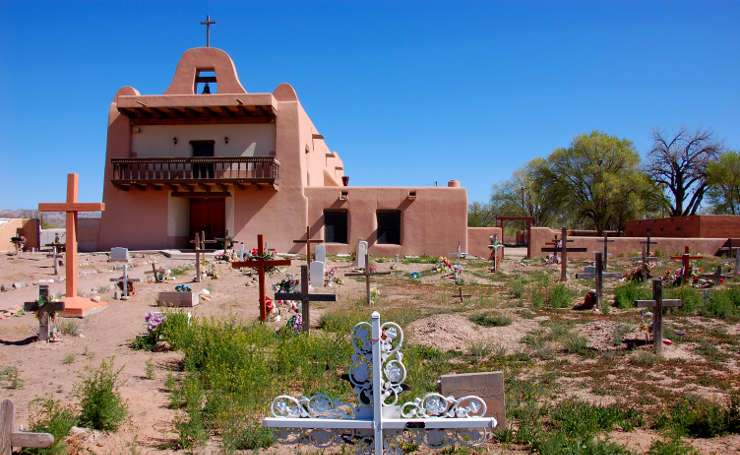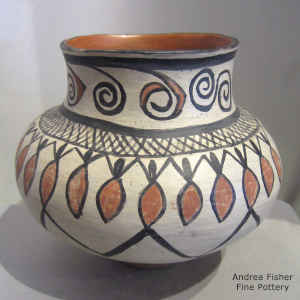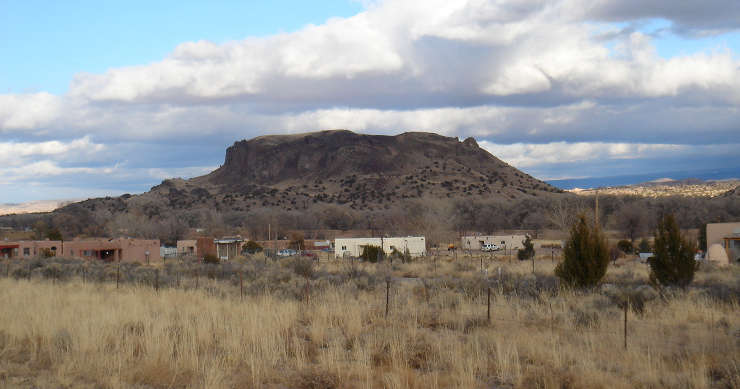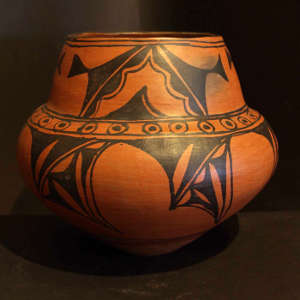San Ildefonso Pueblo
- Po-Woh-Ge: Where the Water Cuts Through
- Language: Tewa
- Size: 26,000 acres
- Population: 600
San Ildefonso Pueblo was home to Maria Martinez, probably the most famous of all Pueblo potters. And Maria turned the Pueblo pottery world upside down beginning in 1922 when she first added her signature to a pot she'd made. In 1926 she turned it upside down again when she added her husband Julian's signature to the pieces he painted for her.
Maria and Julian also brought black-on-black pottery back to San Ildefonso after it had been forgotten for 500 years. After the flu pandemic of 1918 reduced the tribe to 88 people, Maria and Julain taught everyone else in the pueblo how to make it. Given the general conditions of the time, that's what saved their people from extinction.

San Ildefonso Pueblo Mission Church

By an unknown San Ildefonso potter
8.5 in H by 9.5 in Dia
About 25 miles north of Santa Fe, San Ildefonso Pueblo has been occupied since about 1300. The people trace their origins back to an area north of Mesa Verde. The migration to today's pueblo site included time spent on the Pajarito Plateau in villages like Otowi, Tsankawi, Navawi and Tynonyi.
A Spanish report from 1591 counted about 2,000 people living in the village. Don Juan de Onaté is reported to have visited in 1598 and the first pueblo mission church was completed in 1617. However, the people of San Ildefonso were in the forefront of the Pueblo Revolt of 1680 and that mission church was one of the first missions destroyed.
When the Spanish returned to the area in 1692, they found the people of the pueblo encamped on top of Black Mesa with the people of Santa Clara. The two peoples were able to successfully hold off the Spanish for a couple years but eventually had to come to terms with them. Most villagers returned to the pueblo area in 1694.
The last San Ildefonso uprising occurred in 1696 when the tribe killed two priests and destroyed the newly rebuilt church. It was 1717 before the pueblo had another church built. The present mission church was built between 1957 and 1969.
The population of San Ildefonso after the Pueblo Revolt is estimated at about 800. A series of smallpox epidemics between 1780 and 1793 reduced the population by more than half. The global Spanish flu pandemic in 1918 left only 88 members of the pueblo alive. That forced the pueblo to shift their main economic focus from agriculture to arts and crafts... and that's where Maria Martinez and her family came in.
Pottery History
The potters of San Ildefonso made lots of traditional polychrome pottery for the hundreds of years since they had come down off the Pajarito Plateau and merged with an older indigenous pueblo on the Rio Grande. Their agricultural products supported them but their pottery market began to take off with the arrival of the railroad in the early 1880s.
By 1908, Maria Martinez and her husband, Julian, were building a reputation for the quality of their Tunyo Polychrome pottery: Maria made the pots and Julian painted them. Then the archaeologist Edgar Hewitt asked her if she could make black pottery like the kind he was finding pieces of in the San Ildefonso ancestral home of Tsankawi. The method of making the pottery black had been lost but Maria was the right woman in the right place at the right time. She tried everything she could think of, then she asked Sarafina Tafoya, a potter at Santa Clara Pueblo, if she could help. Sarafina essentially said, "It's easy. Come to my home and let me show you." Maria returned to her home from that visit and worked to refine her process so she could reliably turn out black pottery from red clay.
About 1918, after ten years of trial-and-error, Maria's husband, Julian, perfected a technique for creating a matte black paint that would stick to a polished black surface through the firing. That's when the trademark San Ildefonso black-on-black style was born. Black-on-black went over so well with the tourists and collectors that it sparked a renaissance among pottery makers in other pueblos. Today, the making of pottery is an economic mainstay for the San Ildefonso people.

Black Mesa
Lower photo is in the public domain
